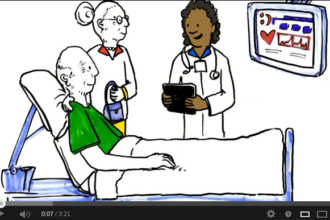In coming years the US could see growing shortages in the availability of primary care physicians (PCPs). With the number of individuals seeking care increasing and the current medical system continuing to incentivize physicians to specialize, the number of available PCPs will decline proportional to the population.
In coming years the US could see growing shortages in the availability of primary care physicians (PCPs). With the number of individuals seeking care increasing and the current medical system continuing to incentivize physicians to specialize, the number of available PCPs will decline proportional to the population. To fill that gap, Ezra Klein and others have asserted that expanded scope of practice will allow nurse practitioners (NPs) to serve as viable substitutes for primary care shortages.
 While NPs serve a vital role in the system and meet need, the argument that they are a 1:1 substitute for PCPs (but for the greedy doctors and pesky regulations holding them back) is singular and shortsighted. The argument also fails to address broader policies that influence both NP and PCP behaviors. Policies that unjustifiably lead to the unequal distribution of caregivers, location or expertise, inherently parlay into unequal care for patients. Sadly, a broader scope than “freeing nurse practitioners” is necessary to meet primary care needs, as NPs are complements, not substitutes. Policy must address the need for more primary care and assist to realign the system to meet our country’s basic care and equality through redistribution.
While NPs serve a vital role in the system and meet need, the argument that they are a 1:1 substitute for PCPs (but for the greedy doctors and pesky regulations holding them back) is singular and shortsighted. The argument also fails to address broader policies that influence both NP and PCP behaviors. Policies that unjustifiably lead to the unequal distribution of caregivers, location or expertise, inherently parlay into unequal care for patients. Sadly, a broader scope than “freeing nurse practitioners” is necessary to meet primary care needs, as NPs are complements, not substitutes. Policy must address the need for more primary care and assist to realign the system to meet our country’s basic care and equality through redistribution.
Primary care is the foundation of the evolving health care system, with equal access the intended goal of the ACA. Along the way to meeting future demand for primary care, NPs can be increasingly utilized to meet the needs of Americans and improve the health of the nation. And let it be known I am a strong proponent and supporter of nurse practitioners and all non-physician providers and coordinators. However, the argument that most NPs practice in primary care and will fill the primary care gap, estimated at about 66 million Americans, is inaccurate. It isn’t a 1:1 substitute, especially given that models of the solo practitioner are vanishing in lieu of complementary and team-based care.
The US, unlike many western countries, does not actively regulate the number, type, or geographic distribution of its health workforce, deferring to market forces instead. Those market forces, however, are paired with a payment system whose incentives favor high volume, high return services rather than health or outcomes. These incentives are reflected in where hospitals steer funding for training, and in the outputs of that training.
Throughout the US there are geographic pockets that fail to attract medical professionals of all kinds, creating true primary care deserts. These deserts occur in part due to the unequal distribution of practitioners in the health care system, with our medical schools and salary opportunities producing low numbers of generalists across the board. We have even continued to see shortages in nurses throughout the US.
In fact, 2012 residency matching rates not only show continued unfilled positions in primary care, but that the rates of graduating minorities are highly skewed from programs. This contributes to even greater problems with finding primary care providers that reflect the populations they serve. Sadly, this is also true for nurse practitioners, where only 4.9% are African American, 3.7% are Asian or Pacific Islander and 2% are Hispanic. Further, the geographic distribution of NPs and physicians assistants alike is close to that of physicians. A June 2013 assessment found that the distribution for urban, rural and isolated rural frontier primary care providers is within a few percentage points for NPs and PCPs.
Ezra Klein was not wrong in his assessment that physicians are often influenced by income. However, it seems likely that financial incentives are drivers for many professionals in the health care sector, including nurse practitioners, registered nurses and physicians assistants (PAs). Dr. Andrew Bazemore, Director of the Robert Graham Center for Policy Studies in Primary Care in Washington, DC has done significant research in this area. His perspective is that, “The suggestion that runaway health system costs could be contained simply by replacing higher salaries of physicians for lower salaried substitutes with less training misses the point – that cost containment will most likely result from optimizing primary care functions such as prevention, population management, care coordination, and avoidance of unnecessary referrals, procedures, ER use and hospitalizations of primary care providers.” Dr. Bazemore asserts that, “Achieving that level of effectiveness likely involves teams that include primary care physicians, NPs, PAs, behavioral and community health workers, and other important components, operating in a transformed practice setting.”
It is also correct that regulation on NPs is onerous and sometimes oppressive. Across the nation, regulation on NPs is exceptionally disjointed and often results in unnecessary hurdles for all involved, called scope-of-practice laws. Although impediments are common in the health care system, it is extensively difficult for NPs and similar non-physicians to break into a system that is deeply rooted in tradition.
However, by honing in on one piece of the puzzle, Mr. Klein missed the bigger picture. The principals of substitution do indicate that on the supply side, NPs stepping into roles for PCPs would better meet demand. But that is not the real world outcome. The broader landscape shows us that instead of a 1:1 substitution, nurse practitioners are compliments in the overall care system, important roles that fulfill many primary care needs.
Therefore, policy changes are still needed to improve patient health outcomes and forge a team-based relationship between care providers. Incentives to enter primary care and needed across the disciplines, as are models of team-based training that build on the strengths of each in managing whole persons and populations. Ezra Klein fails to note that most primary care shortage estimates implicitly include NPs and PAs already working in primary care while not accounting for the fact that NPs and PAs are choosing specialization over primary care for the same reasons as physicians.
Instead of an environment where NPs and PCPs are positioned to compete with one another, federal and state legislators should spend more time crafting policy that equalizes the distribution of care providers across the system. That redistribution means incentivizing, monetarily or otherwise, primary care clinicians to stay in general medicine and work in tandem with other providers. Whether it be the reformation of medical school, constructing a more honest approach to population health or restructuring pay scales and incentives, team-based medicine with improved access and outcomes should be the real discussion.
(the primary care desert / shutterstock)









